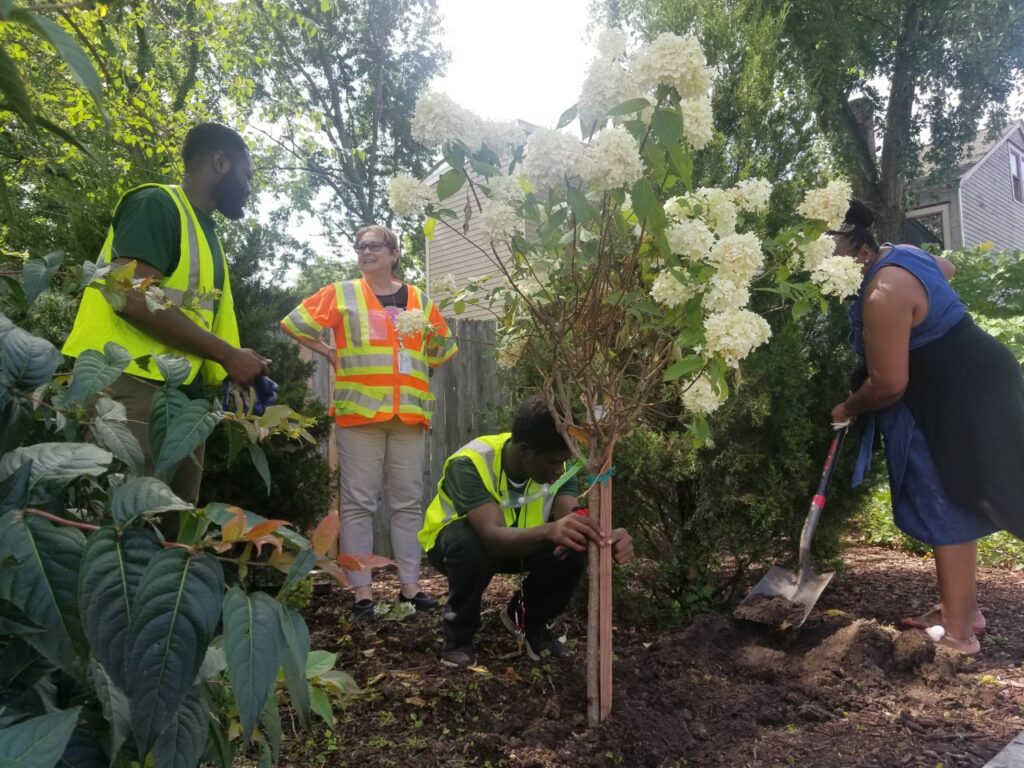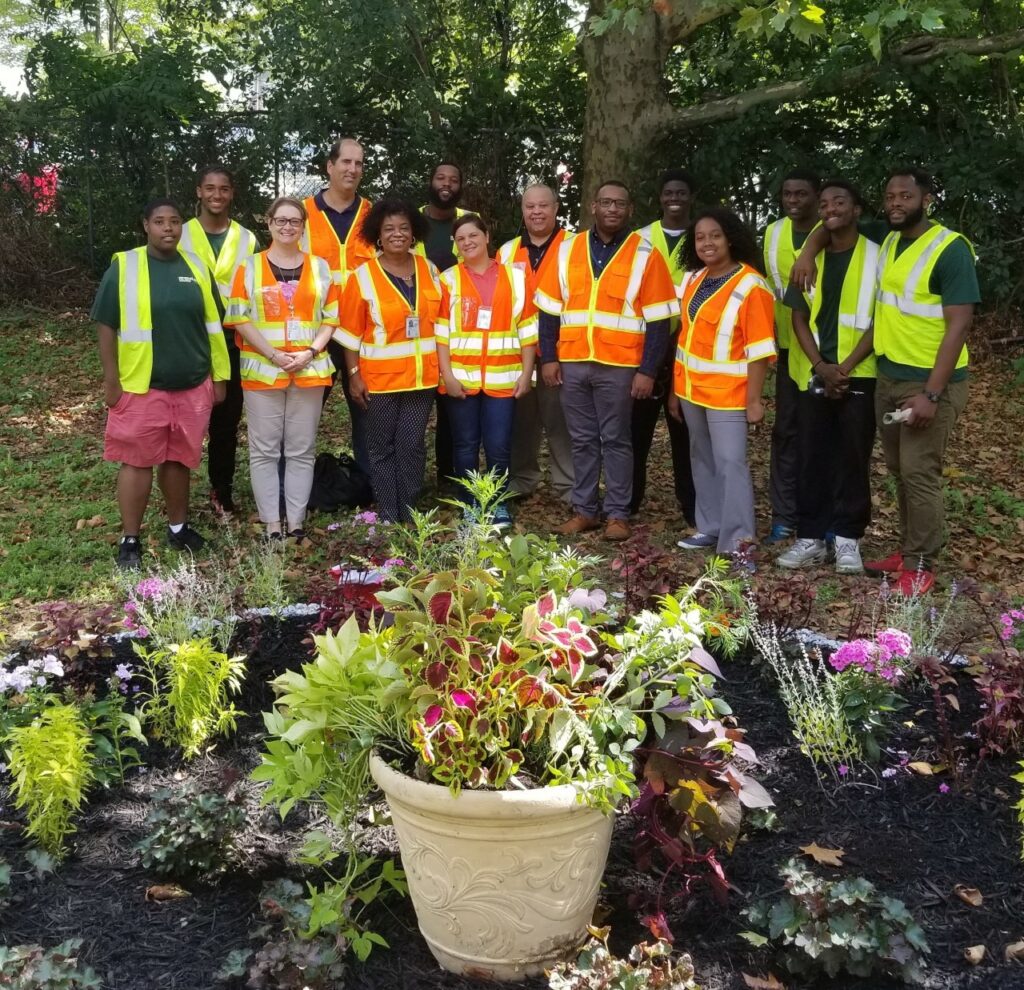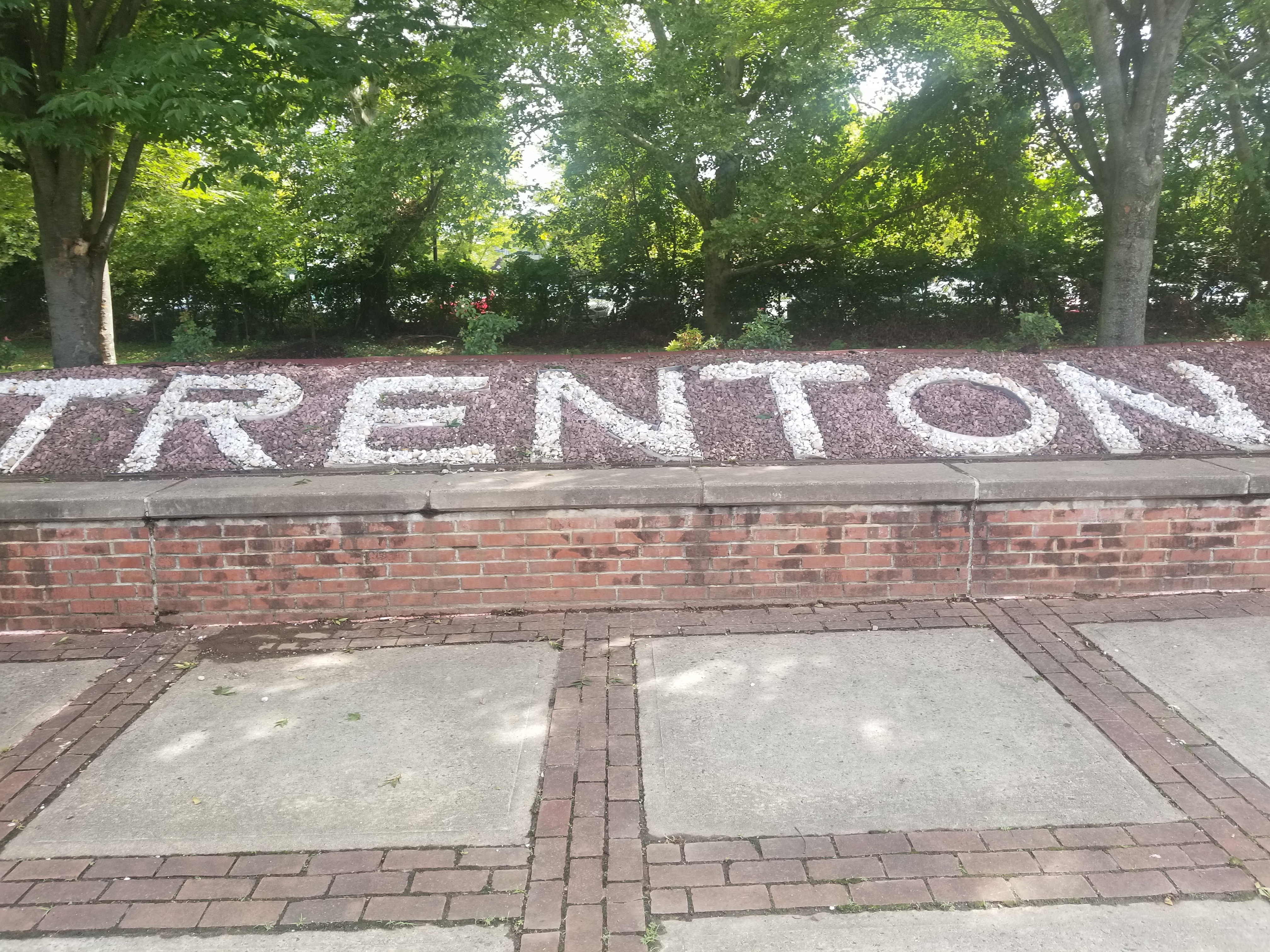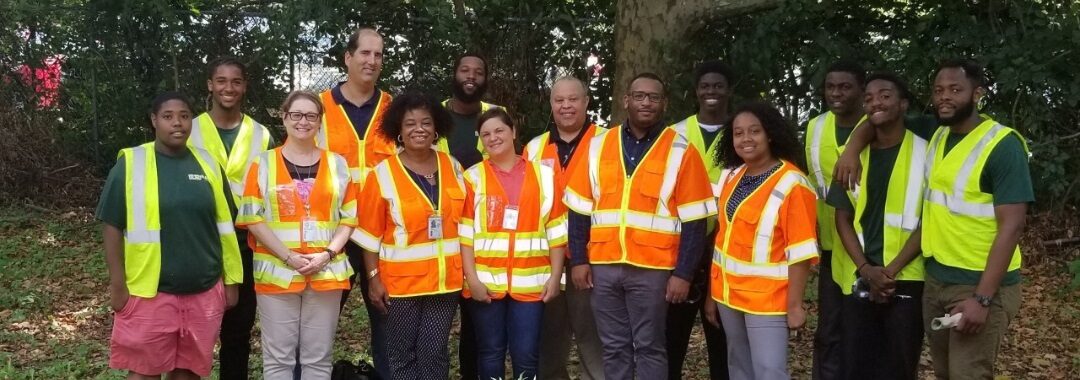Strategic Workforce Development, an innovative initiative of the Every Day Counts Program, suggests the importance of fostering an environment and partnerships favorable to training programs, pre-apprenticeship programs, and support for women and minorities in the construction workforce, among other strategies. NJDOT’s Youth Corps Urban Gateway Enhancement Program promotes workforce development by supporting transportation-related community projects that engage youth and young adults in underserved communities. NJDOT partners with local government agencies, not-for-profits, community-based organizations and other entities with established youth programs to provide summer employment, as well as training and other supportive services, to the program participants working to improve gateway areas at state highways.
We interviewed Chrystal Section, Supervisor of the Non-Discrimination Programs Unit in the NJDOT’s Division of Civil Rights and Affirmative Action. The unit includes Title VI, Environmental Justice, Americans with Disabilities Act, Limited English Proficiency, and two special programs: the Youth Corps Urban Gateway Enhancement program and the National Summer Transportation Institute (NSTI).
Q. The Youth Corps Urban Gateway Enhancement Program has been operating since 1998. What prompted the start of the program?
Members of the Division of Civil Rights attended an AASHTO subcommittee conference on the program. Our division became very interested seeing that it would be beneficial to our youth and young adults in underserved communities. At the time, Civil Rights worked with NJDOT’s Adopt a Highway program to develop the Urban Gateway Enhancement Program.
Q. Is the NJDOT program affiliated with the NJ Department of Labor’s Youth Corps Program in New Jersey?
No. We do not work directly with the NJ Department of Labor Urban Youth Corps program. NJDOT implements the Urban Gateway Enhancement Program with the support of federal funding.
Q. What is your role with the program?
I am the project manager, and I work with the supervisors at the various agencies that are participating. I am responsible for outreach, the website presence including grant cycle announcement and application availability statewide, review of applications, award announcement letters, the kick-off meeting with all the funded organizations, ensuring recipients provide close-out documents for reimbursement, and providing the final project report to FHWA.
Q. How much funding is available to each applicant?
Up to $32,000 is available to each applicant organization. At least 50 percent of the budget must be dedicated to the youth participants in earnings, training and supportive services. Teams are formed with approximately 6 to 10 youths. The funding also pays for the local supervisor, and equipment and supplies as needed.
Some of the applications request less than the grant cap, especially if the organization has participated previously and has purchased costly equipment already.
Q. What might be a typical hourly wage or stipend?
Participants are paid minimum wage, $15/hour, although some of the participating organizations have stipends, so they would pay them based on the stipend. The youths and young adults are not paid less than minimum wage. The participants work four to six hours per day for up to six to eight weeks during the summer.

Q. How do you get the word out about the program?
Our outreach includes sending letters to previous participants and mayors in underserved communities, and we send out a blast on all NJDOT social media platforms including Facebook, Instagram and LinkedIn, and post the notice on the NJDOT website on the Civil Rights and Clean Up NJ webpages.
Q. How are participating organizations chosen?
We accept applications from any entity that fits the criteria set forth in the application. When I first started with the program, I worked primarily with Urban Enterprise Zones but the program has spread through word of mouth. We continue to focus on underserved communities. The applicants must have established youth programs. The goal of NJDOT’s program is to benefit youth and young adults between the ages of 16 and 25 who are economically or socially disadvantaged and who have experienced barriers to employment (e.g., the lack of a high school diploma, homelessness, teen parenting, being physically or mentally challenged, or an ex-offender). These program participants receive training while receiving a paycheck. Depending on the project, they will have an opportunity to learn the basics of urban forestry, landscaping, fabrication and installation of streetscape and pedestrian enhancements, horticulture, construction inspection and materials testing.
Applicants have included cities, youth corps, churches, school districts, and other not-for-profit community-based organizations. Each community organization provides the program’s structure and supervision and also provides life skills, and safety and technical skills training. For examples of grantees and projects, please see Table 1.
As previously noted, some former funding recipients apply in subsequent years, often to continue maintenance on the original project site.
Q. Can you describe the process once you have received the applications?
We receive 14 applications on average each year, and we can usually fund up to 12. A team of 11 NJDOT subject matter experts (SMEs) serve on the application scoring team. These individuals are from several areas including Civil Rights, Local Aid & Economic Development, Community Outreach, Landscape, Project Management, Statewide Planning, Capital Planning and Management, and Operations. Representatives from these departments volunteer their time to review and individually score the applications and then we discuss the scoring and make the awardee selections.
In their applications, the organizations can list up to three site locations and specify the type of projects they will be working on at each location. The projects must be located at gateways to state roadways and be sited on land owned by the State, as NJDOT does not have jurisdiction over county and municipal roadways. Clean-up, maintenance, on-going maintenance from previous projects, anti-graffiti initiatives, planting flowers and trees, and other landscaping are typical projects.
Scoring of the applications takes into consideration whether the project is feasible and provides meaningful and productive work for the participants. Skills training, including work skills, life skills, and safety skills training should be included. Ensuring a safe environment, including providing COVID 19 personal protective equipment and protocols during the pandemic, is also a consideration. Scorers also look for local support for the projects.
Q. Once projects are awarded, what’s next? Does the program leverage the expertise or capabilities of NJDOT employees? How do NJDOT employees get involved in teaching or mentoring in the program?
When we have our kick-off meeting there are representatives from NJDOT Operations and Landscape present to answer any questions. As the project moves forward, we provide technical support as needed, either by meeting with the teams at the project site or answering questions by phone.
Members of the committee visit the project sites during the summer to provide feedback on the great work participants are doing, and to answer questions they may have
Q. What are the benefits of the program?
There are numerous benefits to both NJDOT and the program participants. NJDOT benefits from the opportunity to partner with non-profit agencies and community-based organizations and local governments. The program also provides a prospective employee pool for the Department. The participants benefit from learning about transportation and jobs that are available in the field, and in some cases from the mentorship by NJDOT employees. The participants also gain a sense of ownership of the sites, of pride in their accomplishments and their community. They learn new skills, including life skills, while earning a pay check. This work experience, and employment services offered through the organization, can help them when applying for jobs in the future. The community benefits from an improvement project that beautifies gateway areas so they are inviting to residents and visitors, and from having citizens who are engaged and better equipped to find a job.

Q. What are challenges of the program?
There are three main challenges: continued maintenance of the project sites, obtaining increased funding for the program, and closing out projects in a timely manner at the end of the year.
Ensuring that maintenance is continued for these projects depends on the participating community organizations, as maintenance is not a grant requirement although highly desired. Many recipients have strong relationships with the municipal Department of Public Works (DPW), which may accept responsibility for continued maintenance of the project sites. Others apply for additional funding to maintain the sites.
We would also welcome increased funding that would enable us to support more projects and open the program up to more organizations in the state.
Regarding program close-out requirements, this program is a reimbursement program. At the end of the project, the organizations have to submit payment vouchers and receipts. Delays in the process are common due to the other priorities of the organizations, but NJDOT’s ability to secure new funding from FHWA depends on the successful close-out of the year’s projects. Sometimes, we have to skip a year of the program due to late reporting. For example, we awarded grants in 2021 but skipped the 2022 cycle.
Q. Are there any program changes being discussed?
I have been managing the program independently for the past two years, but I now have two new staff members who are excited about the program. Now that they have joined me, I will have capacity to reach out and see what other states are doing with similar programs to gather lessons learned.
Q. Is there a workforce development component to the program? Are program participants encouraged to apply to NJDOT for employment in Operations or other divisions, bureaus or units?
Our goal is to not limit our investment in these individuals to only summer employment, but to also open the door to employment at NJDOT. In January 2022, we invited our partner organizations to a meeting to make them aware of the Highway Operations Technician (HOT) positions available in Operations. We worked with Human Resources and the Manager of Operations to discuss the way the HOT program works, and the application process at NJDOT. Although there were no promises made for hiring, the organizations could make their youth and young adult program participants aware of these existing job opportunities. NJDOT considers this outreach a continuing investment in the on-the-job training. We hope to hold other meetings in the future when these or similar positions are available – positions that require the skills these individuals have developed through the program. We are looking at this initiative as a component of our workforce development program.
Q. Do you have an example of what you would consider a successful project?
I will give you the example of a Trenton-based program operated by Isles, a non-profit organization, which has been a funding recipient for several years. Their work has focused on a variety of beautification and land management tasks, including installation of a TRENTON sign at Barlow Circle, and improvements at plaza gateways, at the Motor Vehicle Commission building, and at ARTWORKS.

When our team of committee members went out to meet with the program participants who worked on this project, these young people were a little resistant to engage with us at first. But when we toured the project sites together and they had the opportunity to explain their contributions and what they learned, you could see a positive change. They were proud of their accomplishments and happy to share that with us. They were not only earning money but learning skills, including how to prepare a resume and other life skills. It is truly meaningful when we as NJDOT employees have the chance to go out and meet with these young people and have an exchange where they can ask questions about the work we are doing, and we can build relationships.
You can always give funding, but it becomes so meaningful when you have the chance to spend half the day with these young men and women and find out about their work, interests and goals. Overall, it is a wonderful experience to oversee this program for NJDOT, to help make communities beautiful, and see lives positively changing from our efforts.
| Grantee Organization | Municipality | County | Project Locations |
|---|---|---|---|
| The Work Group | City of Camden | Camden | • Grassy triangle at Admiral Wilson Boulevard and Bank Street • Exit 3 off 676 North at Morgan Street |
| City of East Orange Mayor’s Office of Employment and Training (MOET) | City of East Orange | Essex | • Freeway Drive-East • Freeway Drive-West • North Oraton Parkway (Main Street overpass) • Ampere Plaza- 4th Avenue |
| Groundwork Elizabeth | City of Elizabeth | Union | • Kellogg Park • Mattano Park • McPherson Park |
| City of Long Branch | City of Long Branch | Monmouth | • Jackson Woods Park, Route 36 |
| New Brunswick Board of Education/New Jersey Youth Corps of Middlesex County | City of New Brunswick | Middlesex | • War Memorial Park, New Brunswick- Route 27- Lincoln Highway (Northbound) and Route 91 a spur of Route 1- Jersey Avenue (Southbound) • Buccleuch Park, New Brunswick- County Road 527- Easton Avenue (Northbound) and New Jersey State Road Route 18 (Northbound) • Recreation Park, New Brunswick- Route 171 Jersey Avenue (Northbound) |
| City of Passaic | City of Passaic | Passaic | • Madison Street, NJ Route 21 Exit |
| New Jersey Youth Corps of Paterson | City of Paterson | Passaic | • Route 80 • Route 20 • Various entrances or gateways to the City of Paterson, NJ |
| City of Perth Amboy | City of Perth Amboy | Middlesex | • Route 35 (Convery Boulevard) and Route 184 (Pfeiffer Boulevard) • South-West Corner of Smith Street Convery Boulevard (Route 35) and Riverview Drive • Outer High Street and Route 440 Ramp • NJ-184 (Lincoln Drive) |
| New Jersey Youth Corps of Phillipsburg | Town of Phillipsburg | Warren | • NJ 122 (Alt 22) South Main Street 900 Block • South Main Street (Union Square to Walters Park) • US Rte. 22 and Roseberry Street (NW Corner) |
| New Jersey Youth Corps of Atlantic County | City of Pleasantville | Atlantic | • Delilah Road and Franklin Avenue |
| Isles, Inc. | City of Trenton | Mercer | • Route 1/Perry Street. Interchange & adjacent Roberto Clemente Park- on/off ramp, strip between on-ramp and park • Route 1/Market Street at Stockton/Mill Hill Park- on/off ramps, MVC building, planned Artwalk and “Trenton” landscaped sign • Market Street Plaza- gateways that connect Route 1 with Mill Hill and Market Street/Broad Street intersection and corridor |
Resources
NJDOT Youth Corps Urban Gateway Enhancement Program
https://www.state.nj.us/transportation/community/cleanupnj/youth.shtm

